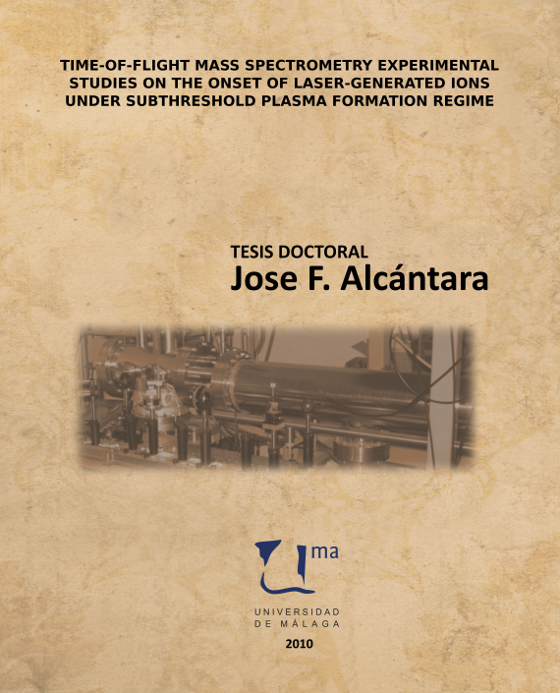Doctoral Thesis
Time-of-Flight Mass Spectrometry Experimental Studies on the Onset of Laser-generated Ions Under Subthreshold Plasma Formation Regime.
Download the digital edition (PDF).

Aquí encontrarás información relativa a la tesis, que puedes descargarte de forma gratuita en formato electrónico desde esta misma página.
¿De qué trata esta tesis?
Direct solids analysis in the absence of wet handling has emerged as an important tool when trying to observe the microstructure of a sample, which defines its properties and applications. Compared to conventional wet analysis, the use of microprobes to perform direct solids analysis has an impact not only on the reduction of the number of sample handling steps, which can lead to reduced measurement errors, but also on the effective time required to perform an analysis, which is dramatically reduced using these methods.
Among many other microprobe analysis techniques developed in the last decades, laser-based techniques stand out due to their advantages, including speed of analysis and negligible damage to the sample, as well as the simplicity introduced by the laser in the instrumental set-up, making the use of complex sampling methods unnecessary. This fact has had a dramatic influence on the spread of this type of technique, which is now routinely used in dozens of laboratories all over the world to carry out analyses of a diverse and varied nature.
Complementary to the development of lasers and their advantages, the high sensitivity of mass spectrometry and the availability of high-frequency electronics capable of handling the large amount of experimental data produced by time-of-flight analysers have helped to extend the use of these ion analysers in experiments dedicated to gaining an understanding of the behaviour of the material removed from a sample as a consequence of the laser-matter interaction process. Therefore, Laser-ionization Mass Spectrometry (LIMS) is one of the fastest, most reliable, sensitive and therefore promising laser techniques widely used for obtaining chemical information from a solid sample.
Download Digital Edition
Complementary electronic information
Check the list of publications for a list of published papers related to this thesis.
This PhD was mostly done in the Laser Laboratory of the University of Málaga. It also contains a chapter based in the work carried out at ISAS-Dortmund and yet another with the work done at ETH Zürich, that wasn’t included in the final memory since it was a different topic. I am grateful to have work in such amazing environments during my PhD.
What you can (and cannot!) do with this PhD thesis
This thesis has been written by Jose Alcántara, who gives it back it to the Public Domain. You may, without prior permission from the author, copy it in any format or medium, reproduce part or all of its contents, sell the copies, use the contents to make a derivative work and in general do anything you could do with a work by an author that has passed into the public domain.
The transfer of a work into the public domain means the end of the author’s economic rights over it, but not of the moral rights, which are inextinguishable. You cannot claim authorship in whole or in part. If you quote from the book or use parts of it to make a new work, you must expressly cite both the author, the title and the edition. You may not use this book or parts of it to insult or commit offences against the honour of persons and in general you may not use it in a way that infringes the moral rights of the author.
Credits
PhD Thesis written by Jose Alcántara.
Cover of the PhD memory also by Jose Alcántara.